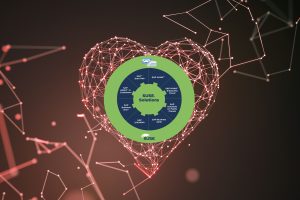SUSE & SAP: When a Partnership Becomes a Romance

People around the world celebrate Valentine’s Day not only as a day of romance for their partners but also to express love and appreciation for family and friends. We asked global market analyst International Data Corporation (IDC) to write a white paper about digital transformation for SAP environments, and SUSE’s partnership with SAP. When the first review draft arrived, I was surprised to see the title “The Benefits of SAP’s and SUSE’s Long-Lasting Romance.” I was tempted to ask if the writers would consider changing the title but as I read the paper, I realized that the words “partner” and “alliance” don’t fully describe the relationship between the two companies.
At first glance, SUSE and SAP may seem like an odd pairing. After all, SAP develops proprietary business operations software and SUSE develops open source infrastructure software. But what makes this relationship special is the collaboration of SAP engineers developing solutions on the SUSE platform, and SUSE engineers not only tuning the software for the SAP applications but also developing unique features specifically for SAP environments. SUSE also does the work to submit platform solutions to SAP for validation or certification as soon as they are available so that businesses can deploy them with confidence. Perhaps the way this relationship has evolved over the last 20 years does make it more of a romance than a partnership.
In this blog, I’ll review some key points of IDC’s perspective on digital transformation for SAP environments and their perspective on where SUSE solutions add value. There will be a link at the end to download the full report.
The State of Digital Transformation (DX)
It’s important to remember that digital transformation is about transforming business operations first and then determining the technologies that are required to make it happen. IDC predicts that in 2020, at least 55% of organizations will be leveraging technology to transform markets, develop new business models, products and services. Spending continues to grow as organizations invest in technologies that help businesses “to achieve speed, scale, and agility.”
Infrastructure platforms and applications that enable this transformation support modern workloads like machine learning (ML), advanced analytics and Internet-of-Things (IoT) as data sources. Traditional transactional and operational data sources are combining with unstructured data to deliver real-time insights and enable predictive analytics for immediate decision-making and future planning.
IDC sees four possible scenarios for SAP customers in the near future and reviews the operational impact of each:
- Start migrating to SAP HANA in the short term
- Delay migration to SAP HANA until SAP no longer supports other databases
- Continue running SAP systems with other databases
- Change business operations to a different vendor
The first scenario is the most prevalent based on IDC’s research. This means that any organization running their existing databases on Microsoft Windows Server™ or UNIX will need to choose a Linux OS to evaluate and migrate based on these features:
- Performance optimization
- High Availability / Disaster Recovery
- Security
- Platform management
- Hybrid or multi-cloud capabilities
SUSE solutions for the SAP Intelligent Enterprise
IDC points out as SUSE expands its portfolio beyond delivering a commercial Linux distribution in the data center, it continues to work closely with SAP to enable application delivery in containers, infrastructure management, and cloud deployments. By collaborating with a broad set of Independent Hardware Vendors (IHVs) and several Cloud Service Providers (CSPs) as partners, SUSE gives businesses the ability to build an SAP infrastructure solution stack that fits their requirements. SUSE offers some key features that are important for mission-critical workloads like SAP applications:
- Automated SAP application system and data recovery
- Support for SAP HANA persistent memory technologies
- Highly redundant storage
- Non-disruptive or minimally disruptive system updates
- Performance optimization and tuning
- Application scaling
IDC’s outlook for the future
The IDC paper closes with expectations for customers planning SAP migrations and their infrastructure preferences. And because Linux is an open source OS, future innovations for SAP systems can be shared and widely adopted. It also lists some challenges and opportunities for IT buyers as well as for SUSE.
Click here to download the full report.
As always, you can follow me on Twitter @MichaelDTabron.
Related Articles
Aug 02nd, 2022
No comments yet